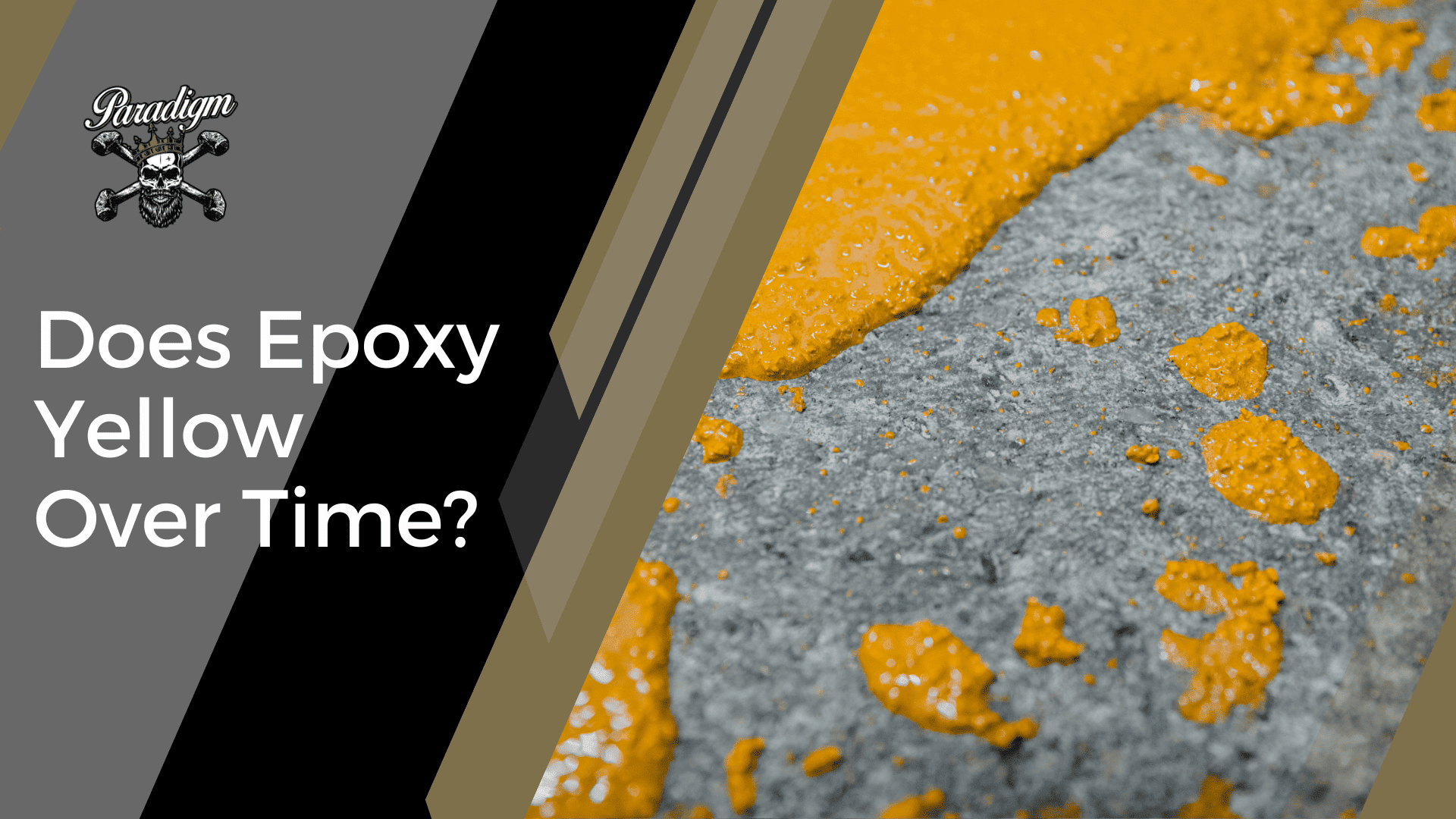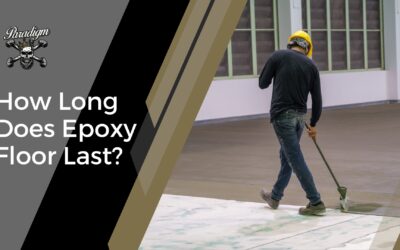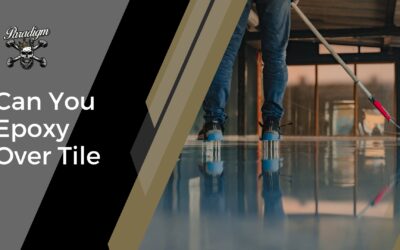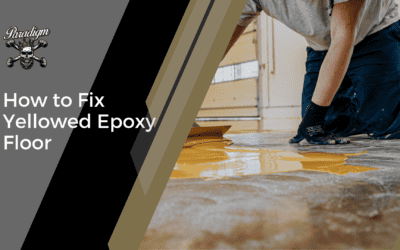Epoxy floors are known for their high gloss and clarity, providing a sleek and polished appearance to any space. However, one question that gets asked often when considering epoxy floors is “Does epoxy floor yellow over time?”
Yes, epoxy can yellow over time and lose its original aesthetics due to certain conditions and environmental factors like exposure to UV radiation, moisture, and humidity.
To minimize the yellowing of epoxy floors, several measures can be taken. You can install high-quality epoxy products that are specifically formulated to resist UV radiation and can significantly reduce the chances of yellowing. Applying a UV-resistant topcoat or sealer over the epoxy floor can also provide an additional layer of protection against discoloration.
Table of Contents
Does Epoxy Yellow Over Time?
Yes, epoxy floor coatings have the potential to turn yellow over time due to various factors such as exposure to UV radiation, high temperatures, humidity, chemical reactions, and the quality of materials or installation. These factors can cause the chemical structure of the epoxy to break down, resulting in a yellowish discoloration of the coating.
Taking preventive measures, such as using UV-resistant epoxy, applying a protective topcoat, and practicing proper maintenance, can help prevent yellowing and maintain the desired appearance of epoxy floors.
Why Do Epoxy Floor Coatings Turn Yellow?
The following are reasons epoxy can turn yellow:
1. UV Exposure
Epoxy coatings are susceptible to the effects of UV radiation. When the epoxy is exposed to sunlight or intense artificial lighting over a prolonged period, the UV rays can break down the chemical bonds in the epoxy.
This degradation process leads to a yellowish discoloration of the coating. Epoxy floors installed in outdoor areas or spaces with significant sunlight exposure are particularly prone to yellowing.
2. High Temperatures
When subjected to elevated temperatures, the chemical reactions within the epoxy can accelerate.
This increased reactivity may cause the epoxy to undergo color changes and turn yellow over time. Areas with excessive heat or proximity to heat sources, such as industrial ovens or hot machinery, can contribute to this yellowing effect.
3. Humidity and Moisture
If the epoxy does not properly cure and harden, it may be more susceptible to color changes, including yellowing.
Moisture can also react with the epoxy and cause discoloration. Spaces with high humidity levels or exposure to moisture, such as bathrooms for basements, can be more prone to epoxy yellowing.
4. Chemical Reactions
Certain chemicals, solvents, or cleaning agents can react with the epoxy and alter its color. These reactions can result in yellowing or discoloration of the coating. It is crucial to use cleaning products and chemicals that are specifically recommended for use with epoxy floors. Avoiding incompatible substances can help prevent unwanted chemical reactions and yellowing.
5. Quality of Materials and Installation
The quality of the epoxy materials used and the installation process can also impact the likelihood of yellowing. Lower-quality epoxy products may contain impurities or may not be formulated to resist yellowing over time.
Also, improper mixing ratios during installation can affect the epoxy’s performance and increase the risk of yellowing. It is important to use high-quality epoxy products and ensure proper installation techniques are followed to minimize the potential for yellowing.
Can You Prevent Yellowing?
It may not be possible to completely prevent the yellowing of epoxy floor coatings. Nonetheless, there are measures you can take to reduce the risk and slow down the yellowing process. Here are some preventive steps:
1. UV-Resistant Epoxy
Opt for epoxy coatings that are specifically formulated to be UV-resistant. These coatings contain additives such as UV stabilizers and inhibitors that help protect the epoxy from the damaging effects of UV radiation.
The UV-resistant properties of these coatings help to slow down the yellowing process and extend the lifespan of the epoxy floor.
2. Topcoat or Sealant
Applying a UV-resistant topcoat or sealant over the epoxy floor provides an additional layer of protection. These products contain UV-blocking agents that act as a shield against UV radiation, reducing its impact on the epoxy.
The topcoat or sealant forms a protective barrier that helps preserve the color and appearance of the epoxy and slows down yellowing.
3. Control UV Exposure
Limiting the exposure of the epoxy floor to direct sunlight or intense artificial lighting can help minimize yellowing. Use window coverings, blinds, or curtains to block out sunlight during peak UV hours.
This is particularly important for areas with large windows that allow significant UV penetration. Consider installing UV-filtering films on windows to reduce the amount of UV radiation reaching the epoxy floor.
4. Temperature and Humidity Control
Maintaining optimal temperature and humidity levels in the environment where the epoxy floor is installed can help prevent yellowing.
Extreme heat can accelerate the chemical reactions within the epoxy, leading to color changes and yellowing. High humidity levels can affect the curing process and increase the risk of discoloration. Ensure proper ventilation and utilize climate control systems to regulate temperature and humidity, creating a stable environment for the epoxy floor.
5. Proper Maintenance
Regular and proper maintenance is essential to prevent the yellowing of epoxy floors. Always clean the floor regularly using mild, non-abrasive cleaners that are specifically recommended for use on epoxy surfaces. Avoid using harsh chemicals, solvents, or abrasive cleaning agents that can react with the epoxy and cause discoloration. Promptly clean up any spills to prevent staining and potential chemical reactions that can contribute to yellowing.
6. High-Quality Materials and Installation
Using high-quality epoxy products and ensuring proper mixing ratios during installation is crucial to minimize the risk of yellowing. Lower-quality epoxy products may contain impurities or lack UV-resistant properties, making them more prone to yellowing.
Investing in reputable epoxy brands and professional installation ensures that the epoxy is of high quality and applied correctly, reducing the chances of yellowing over time.
Are There Epoxy Floor Coatings That Won’t Turn Yellow?
Yes, there are epoxy floor coatings available in the market that are specifically formulated to resist yellowing. These specialized epoxy formulations often incorporate UV-resistant properties, which protect the epoxy from the damaging effects of UV radiation. UV stabilizers and inhibitors are added to the coatings to minimize the discoloration caused by prolonged exposure to sunlight or intense artificial lighting.
Furthermore, manufacturers of these yellowing-resistant epoxy coatings prioritize the use of high-quality raw materials. They carefully select ingredients that have a lower propensity to yellow or discolor over time.
It’s important to note that while these yellowing-resistant epoxy coatings can significantly reduce the risk of discoloration, they may not be completely immune to all factors that can cause yellowing.
How to Fix Yellowed Epoxy Floors
To fix yellowed epoxy floors, you can take the following steps:
1. Assess the extent of yellowing
Start by examining the yellowed epoxy floor to determine the severity of the discoloration. Assess whether the yellowing is localized or spread across the entire floor.
This evaluation will help you decide on the most suitable approach to address the issue and whether you need professional assistance or can handle it yourself.
2. Clean the floor
Before attempting any further steps, it’s essential to thoroughly clean the yellowed epoxy floor. Use a mild, non-abrasive cleaner specifically formulated for epoxy surfaces.
Avoid using harsh chemicals, solvents, or abrasive cleaning agents, as they can potentially damage the epoxy further. Follow the manufacturer’s instructions for the cleaner and ensure you clean the floor uniformly, paying extra attention to the yellowed areas.
3. Sand the yellowed areas (if necessary)
If the yellowing is stubborn and not resolved through cleaning alone, you may consider lightly sanding the affected areas. Use a fine-grit sandpaper or a buffing pad to gently sand the yellowed epoxy surface.
Be cautious not to sand too aggressively, as this can damage the epoxy. The goal is to remove the discolored layer, exposing a fresh surface underneath.
4. Apply a new epoxy coating
Once the floor is cleaned and sanded (if necessary), you can apply a fresh coat of epoxy to restore the appearance of the floor. Make sure to select a high-quality epoxy coating that is specifically formulated to resist yellowing. Follow the manufacturer’s instructions regarding the application process, mixing ratios, and curing times. Apply the epoxy evenly, using a roller or a brush, and ensure complete coverage of the yellowed areas.
5. Consider professional refinishing
If the yellowing is extensive, or stubborn, or if you are uncertain about the DIY approach, it may be best to seek professional assistance.
At paradigm concrete finishes, we have the expertise and specialized equipment to properly refine yellowed epoxy floors. After you consult with us, we come into your space, assess the situation, perform necessary repairs, and apply a new epoxy coating professionally, ensuring a seamless and long-lasting finish.
How Does the Yellowing of Epoxy Floors Over Time Compare to Other Flooring Materials?
The yellowing of epoxy floors over time is a common issue that can occur due to various factors, including exposure to UV light, heat, moisture, and chemical contaminants. Unlike some other flooring materials, such as hardwood or tile, epoxy floors are susceptible to discoloration and yellowing, particularly in areas with high foot traffic or direct sunlight. While regular maintenance and proper care can help prolong the appearance of epoxy floors, homeowners may need to address yellowing through refinishing or recoating to restore the floor’s aesthetic appeal.
Can Epoxy Be Applied Over Tile Floors, and How Does This Compare to Other Flooring Options?
Epoxy can be applied over tile floors as a cost-effective and durable solution to update the appearance of existing tiled surfaces. Unlike other flooring options, such as hardwood or carpet, epoxy offers a seamless and waterproof finish that can withstand heavy use and resist stains, scratches, and yellowing over time. However, proper surface preparation is essential to ensure adhesion and longevity when applying epoxy over tile. This process typically involves cleaning, etching, and priming the tile surface to promote bonding and prevent peeling or delamination. Homeowners seeking to rejuvenate their tile floors with epoxy can enjoy a versatile and long-lasting flooring solution that enhances both aesthetics and functionality.




